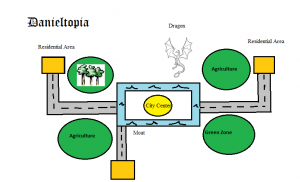Hello Everyone,
My research paper is focused on answering whether or not the Garden City Movement has had a positive, reconnecting influence on the lost relationship between people and nature. I am arguing that despite his efforts to reconnect people to their environment through a number of natural incorporation’s, his plans were too idealistic and did not work within a capitalist framework of society; however, his ideas should not be discredited because they provided an alternative to existing paradigms and has had some success in reshaping the city planning process.
We spent a few classes discussing Howard and his ideas, so I believe some of you may be interested in learning a little more about his life, ideologies and accomplishments.
It is said that there were two major inventions in the beginning of the twentieth century; the invention of the airplane, and Ebenezer Howards’ creation of the Garden City. Howard was born in London in 1850 and was the son of a shopkeeper. He travelled to America at the age of twenty one, taking on 160 acres of land in Howard County, Nebraska to plant cucumbers, watermelon and potatoes. He returned to jolly old England five years later and invented the famous Remington typewriter. He married Elizabeth Ann Bills, had three sons, and one daughter.
Howard was intrigued by radical liberal thinkers, those desiring liberal reformation, and the benefits of socialism. He embraced spiritualism. With Charles Darwin’s publishing of Descent of Man, Howard found himself involved in a religious crisis and moved towards “Modern Spiritualism”. Howard began to believe that he had acquired a God-given order of the world, and therefore, the path of humanity relied on his concept of city planning to reach a level of higher civility. Also, the enlightenment of individuals would lead humanity into accepting his grand design and its inherent existence in the order of the universe.
Influenced by the Garden City concept, the Garbatella neighborhood was designed to house railway and dock workers built by the Instituto per le Case Popolari (ICP). This neighborhood a low-income housing project aimed at providing for the lower working classes in Rome, and could easily be distinguished from other Roman cities built in the nineteen-twenties. The Garbatella was one of the most successful children of Howard’s ideas, mainly because the inhabitants aspired to his ideals. Nonetheless, the Garbatella failed to live up to its high expectations because of a rapid expansion and the resulting population density that were not characteristic of the model Garden City. In 1922, the city only had 3,400 citizens and four years later reached upwards of 24,000! Although it did not meet its full potential, the Garbatella still exhibited signs of an extra communal neighborhood and distinctive Roman individuality. With the rise of Mussolini and his Fascist regime, the Garbatella was transformed the appearance, but its character and communal unity stayed intact.
What do you guys think about his Garden City concept? Are there any positive outcomes that come out of his planning, or is it all too idealistic and romantic of society? Does a natural landscape, and closeness of a ‘hinterland’ improve your living conditions? Does Kelowna have any reminiscent traits of a Garden City? Exciting stuff…..I know your as intrigued as I am.

